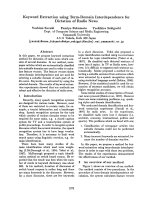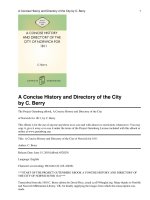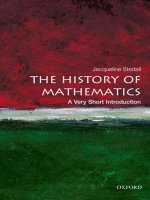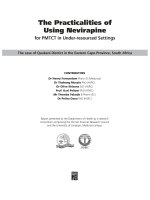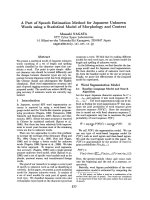Using history for popularization of mathematics
Bạn đang xem bản rút gọn của tài liệu. Xem và tải ngay bản đầy đủ của tài liệu tại đây (1.06 MB, 36 trang )
Using history for
popularization of mathematics
Franka Miriam Brückler
Department of Mathematics
University of Zagreb
Croatia
www.math.hr/~bruckler/
What is this about?
• Why should pupils and students
learn history of mathematics?
• Why should teachers use history of
mathematics in schools?
• How can it be done?
• How can it improve the public image
of mathematics?
Advantages of mathematicians
learning history of math
• better communication with non-mathematicians
• enables them to see themselves as part of the
general cultural and social processes and not to
feel “out of the world”
• additional understanding of problems pupils and
students have in comprehending some mathematical
notions and facts
• if mathematicians have fun with their discipline
it will be felt by others; history of math provides
lots of fun examples and interesting facts
History of math for school teachers
• plenty of interesting and fun examples to enliven
the classroom math presentation
• use of historic versions of problems can make
them more appealing and understandable
• additional insights in already known topics
• no-nonsense examples – historical are perfect
because they are real!
• serious themes presented from the historical
perspective are usually more appealing and often
easier to explain
• connections to other scientific disciplines
• better understanding of problems pupils have and
thus better response to errors
making problems more interesting
visually stimulating
proofs without words
giving some side-comments can enliven the class
even when (or exactly because) it’s not
requested to learn... e.g. when a math symbol
was introduced
• making pupils understand that mathematics is
not a closed subject and not a finished set of
knowledge, it is cummulative (everything that
was once proven is still valid)
• creativity – ideas for leading pupils to ask
questions (e.g. we know how to double a sqare,
but can we double a cube -> Greeks)
• showing there are things that cannot be done
•
•
•
•
• history of mathematics can improve the
understanding of learning difficulties; e.g. the use
of negative numbers and the rules for doing
arithmetic with negative numbers were far from
easy in their introducing (first appearance in India,
but Arabs don’t use them; even A. De Morgan in the
19th century considers them inconceavable; though
begginings of their use in Europe date from
rennaisance – Cardano – full use starts as late as
the 19th century)
• math is not dry and mathematicians are human
beeings with emotions anecdotes, quotes and
biographies
• improving teaching following the natural process
of creation (the basic idea, then the proof)
•for smaller children: using the development of
notions
•for older pupils: approach by specific historical
topics
•in any case, teaching history helps learning how
to develop ideas and improves the understanding
of the subject
•it is good for giving a broad outline or overview
of the topic, either when introducing it or when
reviewing it
Example 1: Completing a square /
solving a quadratic equation
al-Khwarizmi (ca. 780-850)
x2 + 10 x = 39
x2 + 10 x + 4·25/4 = 39+25
(x+5)2 = 64
x + 5 = 8
x = 3
Example 2: The Bridges of Königsberg
The problem as such is a problem in recreational math.
Depending on the age of the pupils it can be presented just as
a problem or given as an example of a class of problems
leading to simple concepts of graph theory (and even
introduction to more complicated concepts for gifted
students).
The Bridges of Koenigsberg can also be a good
introduction to applications of mathematics, in this
case graph theory (and group theory) in chemistry:
Pólya – enumeration of isomers (molecules which differ only in the
way the atoms are connected); a benzene molecule consists of 12
atoms: 6 C atoms arranged as vertices of a hexagon, whose edges are
the bonds between the C atoms; the remaining atoms are either H or
Cl atoms, each of which is connected to precisely one of the carbon
atoms. If the vertices of the carbon ring are numbered 1,...,6, then a
benzine molecule may be viewed as a function from the set {1,...,6} to
the set {H, Cl}.
Clearly benzene isomers are invariant under
rotations of the carbon ring, and reflections of
the carbon ring through the axis connecting two
oppposite vertices, or two opposite edges, i.e.,
they are invariant under the group of symmetries
of the hexagon. This group is the dihedral group
Di(6). Therefore two functions from {1,..,6} to {H,
Cl} correspond to the same isomer if and only if
they are Di(6)-equivalent. Polya enumeration
theorem gives there are 13 benzene isomers.
Example 3: Homework problems (possible: group
work)
possible explorations of old books or specific topics, e.g.
Fibonacci numbers
and nature
Fibonacci’s biography
rabbits, bees, sunflowers,pinecones,...
reasons for seed-arrangement
(mathematical!)
connections to the Golden number,
regular polyhedra, tilings, quasicrystals
Flatland
Flatland. A Romance of Many Dimensions. (1884) by
Edwin A. Abbott (1838-1926).
ideas for introducing higher dimensions
also interesting social implications (connections to
history and literature)
Example 4: Proofs without words
Pythagorean number theory
2(1+2+...+n)=n(n+1)
1+3+5+...+(2n-1)=n2
Connections with other sciences – Example: Chemistry
Polyhedra – Plato and Aristotle - Molecules
What is a football? A polyhedron made up of regular pentagons and
hexagons (made of leather, sewn together and then blouwn up tu a
ball shape). It is one of the Archimedean solids – the solids whose
sides are all regular polygons. There are 18 Archimedean solids, 5 of
which are the Platonic or regular ones (all sides are equal polygons).
There are 12 pentagons and 20 hexagons on the
football so the number of faces is F=32. If we count
the vertices, we’ll obtain the number V=60. And
there are E=90 edges. If we check the number VE+F we obtain
V-E+F=60-90+32=2.
This doesn’t seem interesting until connected to the
Euler polyhedron formula which states taht V-E+F=2
for all convex polyhedrons. This implies that if we
know two of the data V,E,F the third can be
calculated from the formula i.e. is uniquely
determined!
In 1985. the football, or officially: truncated icosahedron, came
to a new fame – and application: the chemists H.W.Kroto and
R.E.Smalley discovered a new way how pure carbon appeared. It
was the molecule C60 with 60 carbon atoms, each connected to 3
others. It is the third known appearance of carbon (the first two
beeing graphite and diamond). This molecule belongs to the class
of fullerenes which have molecules shaped like polyhedrons
bounded by regular pentagons and hexagons. They are named
after the architect Buckminster Fuller who is famous for his
domes of thesame shape. The C60 is the only possible fullerene
which has no adjoining pentagons (this has even a chemical
implication: it is the reason of the stability of the molecule!)
Anecdotes
enliven the class
show that math is not a dry subject and
mathematicians are normal human beeings with
emotions, but also some specific ways of thinking
can serve as a good introduction to a topic
Norbert Wiener was walking through a Campus when
he was stopped by a student who wanted to know an
answer to his mathematical question. After
explaining him the answer, Wiener asked: When you
stopped me, did I come from this or from the other
direction? The student told him and Wiener sadi:
Oh, that means I didn’t have my meal yet. So he
walked in the direction to the restaurant...
Georg Pólya told about his famous english colleague Hardy the follow-ing
story: Hardy believed in God, but also thought that God tries to make
his life as hard as possible. When he was once forced to travel from
Norway to England on a small shaky boat during a storm, he wrote a
postcard to a Norwegian colleague saying: “I have proven the Riemann
conjecture”. This was not true, of course, but Hardy reasoned this way:
If the boat sinks, everyone will believe he proved it and that the proof
sank with him. In this way he would become enourmosly famous. But
because he was positive that God wouldn’t allow him to reach this fame
and thus he concluded his boat will safely reach England!
In 1964 B.L. van der Waerden was visiting professor in Göttingen. When
the semester ended he invited his colleagues to a party. One of them,
Carl Ludwig Siegel, a number theorist, was not in the mood to come and,
to avoid lenghty explanations, wrote a short note to van der Waerden
kurz, saying he couldn’t come because he just died. Van der Waerden
replyed sending a telegram expressing his deep sympathy to Siegel
about this stroke of the fate...
It is reported that Hermann Amandus
Schwarz would start an oral examination
as follows:
Schwarz: “Tell me the general equation
of the fifth degree.”
Student: “ax5+bx4+cx3+dx2+ex+f=0”.
Schwarz: “Wrong!”
Student: “...where e is not the base of
natural logarithms.”
Schwarz: “Wrong!”
Student: ““...where e is not necessarily
the base of natural logarithms.”
Quotes from great mathematicians
ideas for discussions or simply for enlivening the class
•Albert Einstein (1879-1955)
Imagination is more important than knowledge.
•René Descartes (1596-1650)
Each problem that I solved became a rule which served
afterwards to solve other problems.
•Georg Cantor (1845-1918)
In mathematics the art of proposing a question must be held
of higher value than solving it.
•Augustus De Morgan (1806-1871)
The imaginary expression (-a) and the negative expression
-b, have this resemblance, that either of them occurring as
the solution of a problem indicates some inconsistency or
absurdity. As far as real meaning is concerned, both are
imaginary, since 0 - a is as inconceivable as (-a).
Conclusion
There is a huge ammount of topics from history which can
completely or partially be adopted for classroom presentation.
The main groups of adaptable materials are
anecdotes
quotes
biographies
historical books and papers
overviews of development
historical problems
The main advantages are (depending on the topic and
presentation)
imparting a sense of continuity of mathematics
supplying historical insights and connections of mathematics
with real life (“math is not something out of the world”)
plain fun
General popularization
There is another aspect of popularization of
mathematics: the approach to the general public.
Although this is a more heterogeneous object of
popularization, there are possibilities for bringing
math nearer even to the established math-haters.
Besides talking about applications of mathematics,
there are two closely connected approaches: usage of
recreational mathematics and history of mathematics.
The topics which are at least partly connected to history of mathematics are usually more easy to be adapted for public presentation. It is usually more easy
to simplify the explanations using historical
approaches and even when it is not, history provides
the frame-work for pre-senting math topics as
interesting stories.
important for all public presentation
since the patience-level for reading math
texts is generally very low.
history of mathematics gives also various
ideas for interactive presentations,
especially suitable for science fairs and
museum exhibitions
Actions in Croatia
• University fairs – informational posters (e.g. women
mathematicians, Croatian mathematicians); game
of connecting mathematicians with their biographies;
the back side of our informational leaflet has
quotes from famous mathematicians
• Some books in popular mathematics published in
Croatia: Z. Šikić: “How the modern mathematics was
made”, “Mathematics and music”, “A book about
calendars”
•The pupils in schools make posters about famous
mathematicians or math problems as part of their
homework/projects/group activities
The Teaching Section of the Croatian Mathematical
Society decided a few years back to initiate
publishing a book on math history for schools; the
book “History of Mathematics for Schools” has just
come out of print
•The authors of math textbooks for schools are
requested (by the Teaching Section of the Croatian
Mathematical Society) to incorporate short historical
notes (biographies, anecdotes, historical problems ...)
in their texts; it’s not a rule though
• “Matka” (a math journal for pupils of about
gymnasium age) has regular articles “Notes from
history” and “Matkas calendar” starting from the first
edition; they write about famous mathematicians and
give historical problems
•
• “Poučak” (a journal for school math teachers) uses
portraits of great mathematicians on their leading
page and occasionally have texts about them
•“Osječka matematička škola” (a journal for pupils and
teachers in the Slavonia region) has a regular section
giving biographies of famous mathematicians;
occasionally also other articles on history of
mathematics
• The new online math-journal math.e has regular
articles about math history; the first number also has
an article about mathematical stamps
• All students of mathematics (specializing for
becoming teachers) have “History of mathematics” as
an compulsory subject



